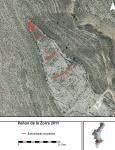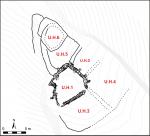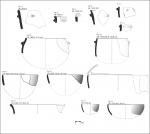Summary (English)
In the archaeological campaign developed in July 2011, excavations were focused on exploring the stratigraphic possibilities of the settlement. By the end of the campaign, archaeologists had identified various wall-like structures corresponding to six rooms of differing sizes and layouts, as well as an access system leading to a few of them. On a preliminary basis, it can be established that the living space on the hill’s upper terrace is structured around six units separated by walls, and that these units define a floor of roughly triangular shape. The two housing units located at the uppermost point appear to be smaller in size and exhibit a number of characteristics that distinguish them from the rest. There are transit areas located around the different housing units, specifically between the cliffs and enclosing walls. The path on the eastern side is the widest of these transit areas and encircles the outer part of the living space.
In addition to the units documented in the current superficial excavation campaign, other units were observed after removing the superficial stratum, indicating a significant architectural complexity. At the present time it is difficult to characterize these structures; however, their size, the effort invested in their construction, and the fact that they are raised and can be distinguished from other housing units dissuade interpreting them for the time being as domestic areas.
Besides the architectural characteristics of the settlement, the information collected throughout the 2011 campaign allows for preliminary assessments of a chronological and cultural nature. The discovery of a triangular copper knife with square rivets points to a more recent timeline than the one that had initially been established based on J.M. Soler’s findings in the sixties. The presence of this object is consistent with various fragments of carinated vessels that could be linked to moments prior to the establishment and development of the Argaric culture in the Southeast of the Iberian Peninsula. Also in accordance with this chronology are various fragments of decorated rims that are suggestive of the Bronze Age in the La Mancha region. Several fragments with bell-shaped engravings introduce a certain antiquity to the excavation sites that is more characteristic of the Copper Age than the Bronze Age, a fact also supported by ceramic engineering. In addition to the aforementioned elements, others (flint sickle flakes, a scarcity of open forms, etc.) that point to the transition between the Copper and Bronze Ages – between 2400 and 2200 BC – can be observed, except the last fragment, whose timeline will be corroborated by means of dating the collected botanical samples.
(translation by Emily Marie Polacek)
- Gabriel García Atiénzar
Director
- Gabriel García Atiénzar (Universidad de Alicante)
Team
- Francisco Javier Jover Maestre, Juan Antonio López Padilla, Carmen Tormo Cuñat, Guillem Pérez Jordà e Ignasi Segura Martínez
- Museo Arqueológico Municipal José María Soler
Research Body
- Colegio Oficial de Doctores y Licenciados en Filosofía y Letras y en Ciencias de Alicante - Sección de Arqueología
- Universidad de Alicante
Funding Body
- Universidad de Alicante






![Download [PDF]](/excavation/skins/fasti/images/results/download_sml.png)


